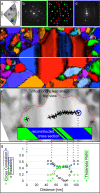Towards 3D crystal orientation reconstruction using automated crystal orientation mapping transmission electron microscopy (ACOM-TEM)
- PMID: 29527435
- PMCID: PMC5827809
- DOI: 10.3762/bjnano.9.56
Towards 3D crystal orientation reconstruction using automated crystal orientation mapping transmission electron microscopy (ACOM-TEM)
Abstract
To relate the internal structure of a volume (crystallite and phase boundaries) to properties (electrical, magnetic, mechanical, thermal), a full 3D reconstruction in combination with in situ testing is desirable. In situ testing allows the crystallographic changes in a material to be followed by tracking and comparing the individual crystals and phases. Standard transmission electron microscopy (TEM) delivers a projection image through the 3D volume of an electron-transparent TEM sample lamella. Only with the help of a dedicated TEM tomography sample holder is an accurate 3D reconstruction of the TEM lamella currently possible. 2D crystal orientation mapping has become a standard method for crystal orientation and phase determination while 3D crystal orientation mapping have been reported only a few times. The combination of in situ testing with 3D crystal orientation mapping remains a challenge in terms of stability and accuracy. Here, we outline a method to 3D reconstruct the crystal orientation from a superimposed diffraction pattern of overlapping crystals without sample tilt. Avoiding the typically required tilt series for 3D reconstruction enables not only faster in situ tests but also opens the possibility for more stable and more accurate in situ mechanical testing. The approach laid out here should serve as an inspiration for further research and does not make a claim to be complete.
Keywords: 3D reconstruction; ACOM-TEM; STEM; in situ testing; quantitative crystallographic analysis.
Figures


Similar articles
-
Challenges in quantitative crystallographic characterization of 3D thin films by ACOM-TEM.Ultramicroscopy. 2017 Feb;173:84-94. doi: 10.1016/j.ultramic.2016.07.007. Epub 2016 Jul 5. Ultramicroscopy. 2017. PMID: 28011432
-
Reconstructing dual-phase nanometer scale grains within a pearlitic steel tip in 3D through 4D-scanning precession electron diffraction tomography and automated crystal orientation mapping.Ultramicroscopy. 2022 Aug;238:113536. doi: 10.1016/j.ultramic.2022.113536. Epub 2022 Apr 27. Ultramicroscopy. 2022. PMID: 35567967
-
Ultrafine heat-induced structural perturbations of bone mineral at the individual nanocrystal level.Acta Biomater. 2018 Jun;73:500-508. doi: 10.1016/j.actbio.2018.04.004. Epub 2018 Apr 9. Acta Biomater. 2018. PMID: 29649638
-
Cryo-electron microscopy and cryo-electron tomography of nanoparticles.Wiley Interdiscip Rev Nanomed Nanobiotechnol. 2017 Mar;9(2). doi: 10.1002/wnan.1417. Epub 2016 Jun 23. Wiley Interdiscip Rev Nanomed Nanobiotechnol. 2017. PMID: 27339510 Review.
-
Three-dimensional transmission electron microscopy and its application to mitosis research.Methods Cell Biol. 1999;61:81-111. doi: 10.1016/s0091-679x(08)61976-7. Methods Cell Biol. 1999. PMID: 9891310 Review.
References
-
- Legros M, Gianola D S, Hemker K J. Acta Mater. 2008;56:3380–3393. doi: 10.1016/j.actamat.2008.03.032. - DOI
-
- Jin M, Minor A M, Stach E A, Morris J W., Jr Acta Mater. 2004;52:5381–5387. doi: 10.1016/j.actamat.2004.07.044. - DOI
-
- Mompiou F, Legros M. Scr Mater. 2015;99:5–8. doi: 10.1016/j.scriptamat.2014.11.004. - DOI
LinkOut - more resources
Full Text Sources
Other Literature Sources
Molecular Biology Databases
